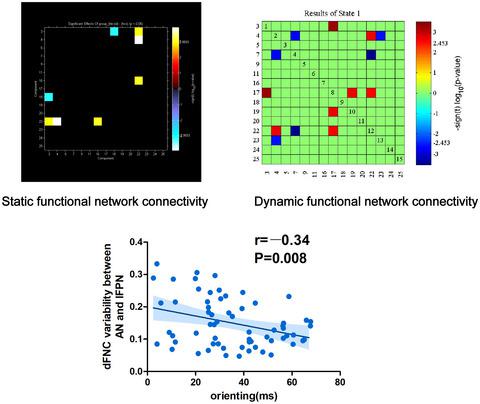当前位置:
X-MOL 学术
›
J. Neurosci. Res.
›
论文详情
Our official English website, www.x-mol.net, welcomes your
feedback! (Note: you will need to create a separate account there.)
Altered static and dynamic functional network connectivity in temporal lobe epilepsy with different disease duration and their relationships with attention
Journal of Neuroscience Research ( IF 2.9 ) Pub Date : 2021-07-16 , DOI: 10.1002/jnr.24915 Xiulin Liang 1 , Xiaomin Pang 1 , Jingyuan Zhao 1 , Lu Yu 1 , Peirong Wu 1 , Xinrong Li 1 , Wutong Wei 1 , Jinou Zheng 1
Journal of Neuroscience Research ( IF 2.9 ) Pub Date : 2021-07-16 , DOI: 10.1002/jnr.24915 Xiulin Liang 1 , Xiaomin Pang 1 , Jingyuan Zhao 1 , Lu Yu 1 , Peirong Wu 1 , Xinrong Li 1 , Wutong Wei 1 , Jinou Zheng 1
Affiliation

|
The brain network alterations associated with temporal lobe epilepsy (TLE) progression are still unclear. The purpose of this study was to investigate altered patterns of static and dynamic functional network connectivity (sFNC and dFNC) in TLE with different durations of disease. In this study, 19 TLE patients with a disease duration of ≤5 years (TLE-SD), 24 TLE patients with a disease duration of >5 years (TLE-LD), and 21 healthy controls (HCs) underwent resting-state functional magnetic resonance imaging and attention network test. We used group independent component analysis to determine the target resting-state networks. Sliding window correlation and k-means clustering analysis methods were used to obtain different dFNC states, temporal properties, and temporal variability. We then compared sFNC and dFNC between groups and found that compared with HCs, TLE-SD patients had increased sFNC between the dorsal attention network and sensorimotor network/visual network (VN), but decreased sFNC between the inferior–posterior default mode network and VN. In the strongly connected dFNC state, TLE-SD patients spent more time, had greater mean dwell time, and showed greater inconsistent abnormal network connectivity. There was a significant negative correlation between the temporal variability of auditory network- left fronto-parietal network connectivity and orienting effect. No significant differences in sFNC and dFNC were detected between TLE-LD and HC groups. These findings suggest that the damage and functional brain network abnormalities gradually occur in TLE patients after the onset of epilepsy, which might lead to functional network reorganization and compensatory remodeling as the disease progresses.
中文翻译:

不同病程颞叶癫痫静态和动态功能网络连接的改变及其与注意力的关系
与颞叶癫痫 (TLE) 进展相关的脑网络改变仍不清楚。本研究的目的是调查不同病程的 TLE 中静态和动态功能网络连接(sFNC 和 dFNC)的改变模式。在这项研究中,19 名病程≤5 年的 TLE 患者(TLE-SD)、24 名病程超过 5 年的 TLE 患者(TLE-LD)和 21 名健康对照者(HCs)接受了静息状态功能磁共振成像和注意力网络测试。我们使用组独立成分分析来确定目标静息状态网络。滑动窗口相关性和k均值聚类分析方法用于获得不同的 dFNC 状态、时间特性和时间可变性。然后我们比较了组间的 sFNC 和 dFNC,发现与 HCs 相比,TLE-SD 患者的背侧注意网络和感觉运动网络/视觉网络(VN)之间的 sFNC 增加,但下-后默认模式网络和 VN 之间的 sFNC 降低. 在强连接 dFNC 状态下,TLE-SD 患者花费更多时间,平均停留时间更长,并且表现出更大的不一致异常网络连接。听觉网络-左额-顶叶网络连通性的时间变异性与定向效应呈显着负相关。在 TLE-LD 和 HC 组之间未检测到 sFNC 和 dFNC 的显着差异。
更新日期:2021-07-16
中文翻译:

不同病程颞叶癫痫静态和动态功能网络连接的改变及其与注意力的关系
与颞叶癫痫 (TLE) 进展相关的脑网络改变仍不清楚。本研究的目的是调查不同病程的 TLE 中静态和动态功能网络连接(sFNC 和 dFNC)的改变模式。在这项研究中,19 名病程≤5 年的 TLE 患者(TLE-SD)、24 名病程超过 5 年的 TLE 患者(TLE-LD)和 21 名健康对照者(HCs)接受了静息状态功能磁共振成像和注意力网络测试。我们使用组独立成分分析来确定目标静息状态网络。滑动窗口相关性和k均值聚类分析方法用于获得不同的 dFNC 状态、时间特性和时间可变性。然后我们比较了组间的 sFNC 和 dFNC,发现与 HCs 相比,TLE-SD 患者的背侧注意网络和感觉运动网络/视觉网络(VN)之间的 sFNC 增加,但下-后默认模式网络和 VN 之间的 sFNC 降低. 在强连接 dFNC 状态下,TLE-SD 患者花费更多时间,平均停留时间更长,并且表现出更大的不一致异常网络连接。听觉网络-左额-顶叶网络连通性的时间变异性与定向效应呈显着负相关。在 TLE-LD 和 HC 组之间未检测到 sFNC 和 dFNC 的显着差异。











































 京公网安备 11010802027423号
京公网安备 11010802027423号